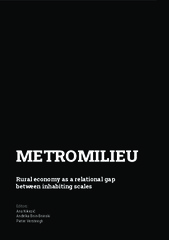Приказ основних података о документу
Human Scale Space and Polarised Communities: New Ruralities as New Forms of Reciprocity and Moderation within the Transition of Modernistic Landscape
| dc.creator | Milojević, Milica P. | |
| dc.creator | Pešić, Mladen | |
| dc.date.accessioned | 2023-11-18T20:53:33Z | |
| dc.date.available | 2023-11-18T20:53:33Z | |
| dc.date.issued | 2021 | |
| dc.identifier.isbn | 978-86-7924-222-8 | |
| dc.identifier.uri | https://raf.arh.bg.ac.rs/handle/123456789/1537 | |
| dc.description.abstract | The mega block pattern was widely used in the construction of new settlements in Belgrade in the 1960s and 1970s, especially in the modernist landscape of New Belgrade. The mega block model has been challenged, among others by sociologists and psychologists for the alienation of man, that is, for the inability of a large agglomeration to establish a relationship with the environment and develop a sense of belonging to the community and place. Planned on the concept of a dwelling community (stambena zajednica), these neighborhoods have undergone significant changes over the last three decades. Close-up view of the mega block’s ambience indicate the presence of the idea of human scale space, whether it was designed or planned that way originally or if it was cultivated that way by residents. Today, in urban practice, planning frameworks are being created for new construction within the mega block, with the model being taken from the traditional city structure (infill of the block’s inner space and building on the regulation), that is supposed to be cost-effective and acceptable for market conditions. The pattern of a traditional city block is being incorporated into the peripheral unbuilt parts of the mega block and as a result social polarization in space is visible. In the 1980s, this pattern of transformation of the mega block by inert filling up of undeveloped surfaces was advocated precisely with the idea of restoring human scale to the oversized public spaces of modernist settlements. Absurdly, the result is just the opposite. In parts of high-density settlements, as a consequence of the construction of new structures in the mega block, we find incomparable differences between polarized communities and reconsider the human scale of megastructures. In what way, under what conditions, in the tension between these two opposing concepts, can we see an opportunity for New ruralities as new forms of reciprocity and moderation? | sr |
| dc.language.iso | en | sr |
| dc.publisher | University of Belgrade - Faculty of Architecture | sr |
| dc.publisher | ARENA architectural research network | sr |
| dc.rights | openAccess | sr |
| dc.source | METROMILIEU: Rural economy as a relational gap between inhabiting scales | sr |
| dc.subject | rurality | sr |
| dc.subject | mega block | sr |
| dc.subject | New Belgrade | sr |
| dc.subject | moderation | sr |
| dc.subject | modernistic landscape | sr |
| dc.title | Human Scale Space and Polarised Communities: New Ruralities as New Forms of Reciprocity and Moderation within the Transition of Modernistic Landscape | sr |
| dc.type | bookPart | sr |
| dc.rights.license | ARR | sr |
| dcterms.abstract | Милојевић, Милица П.; Пешић, Младен; | |
| dc.citation.spage | 38 | |
| dc.citation.epage | 53 | |
| dc.identifier.fulltext | http://raf.arh.bg.ac.rs/bitstream/id/5317/bitstream_5317.pdf | |
| dc.identifier.rcub | https://hdl.handle.net/21.15107/rcub_raf_1537 | |
| dc.type.version | publishedVersion | sr |

